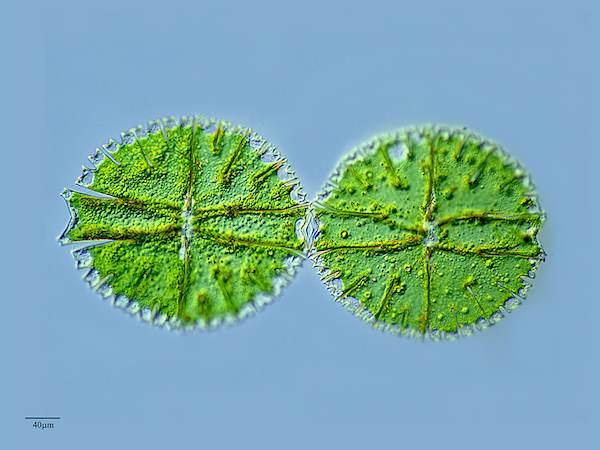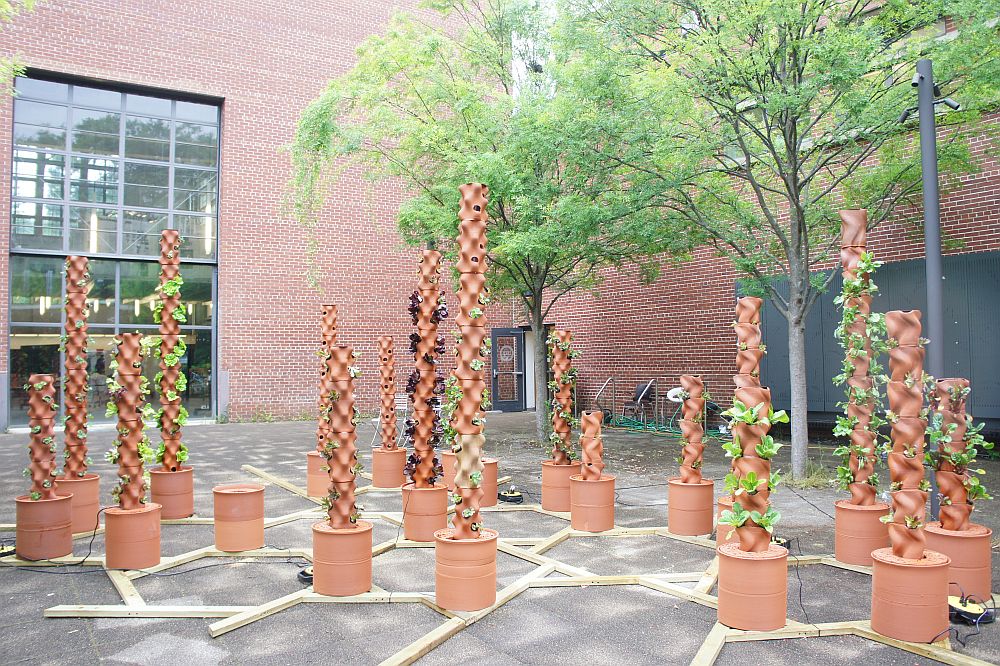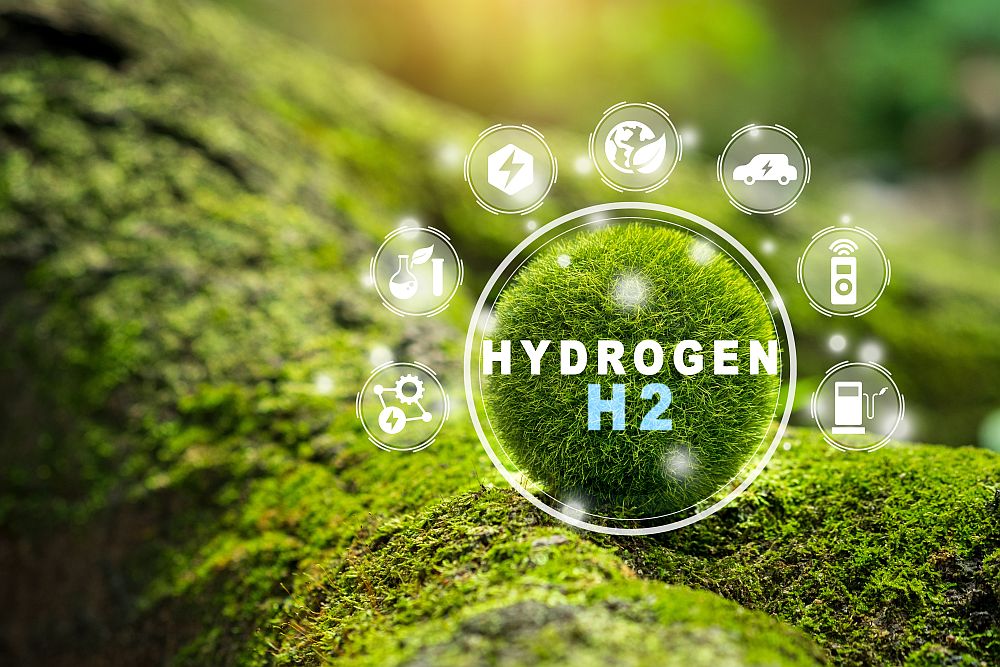
[Image above] Contrast micrograph of two unicellular Micrasterias algae cells. Credit: Proyecto Agua; Flickr CC BY-NC-SA 2.0
The future is green and slimy. (And no, it’s not an episode of You Can’t Do that on Television.)
Algae—those prolific green critters that grow on tops of ponds, lakes, and wet rocks—may be just the answer to alleviate an onslaught of concerns surrounding the future of life on earth, including food scarcity, renewable energy, and excess greenhouse gas.
Algae are eukaryotic organisms (not plant, not animal, but kinda like both) that scientists estimate come in 200,000–800,000 varieties—some of which are unicellar, some multicellular, and all in a variety of colors, shapes, sizes, and such. Blame this confusing variety of algae’s polyphylogeny (algal species appear similar but evolved independently from different ancestors).
Algae include more than those green guys growing atop bodies of water—diatoms, coccolithophores (their tiny skeletons are responsible for chalk and, perhaps surprisingly, the White Cliffs of Dover), and seaweed are also algae.
In all forms, algae are a really important part of the food chain. The critters contain lots of rich proteins and oils, including omega-3 fatty acids. Algae are actually the reason why certain fish are rich sources of omega-3s.
Those same components that make algae a rich dietary source also make them a potential source of biofuel—one that is renewable, cultivatable, and can offset greenhouse gas emissions, too.
Let’s take a quick mo to tally up algae’s pros list so far:
They’re cheap.
They grow like gangbusters.
They’re a rich dietary source.
They’re a source of biofuel.
They can power eco-friendly lamps.
They can help clean up the planet.
They’re terribly tough.
And they’re terribly pretty.
Although they have a few cons, too, algae get a solid thumbs up in my book.
In terms of using algae for biofuel, however, you need a whole heck of a lot of it to solve the world’s energy problems. The good news is that algae are really scalable, and while challenging, scientists estimate that it is within the realm of possiblility to scale algae production high enough to meet many of the energy demands of a growing population.
There’s even a way to scale up production without sacrificing precious land space, by growing algae in photobioreactors. These are closed systems, often consisting of snaking tubing in which the algae can be grown.
And this is one place were Schott has found a good use for some of the 140,000 lbs of glass tubing that it produces every year.
Although photobioreactors can contain tubing made of various materials, glass has noted advantages that Fritz Wintersteller, sales director for Schott’s tubing division, shared with me in a recent phone call.
For one, closed systems allow close monitoring and control of the creatures themselves and their environment—nutrient levels, temperature, pH, carbon dioxide levels, sunlight, etc—making it easier to prevent contamination and optimize growth of the algae themselves.
Schott entered the algae market about a decade ago, says Wintersteller. The Duran glass tubing the company produces for that market is composed of borosilicate glass with a 3.3 thermal expansion coefficient.
Schott has been testing their tubing—both in-house and in collaboration with external institutions and entities—to determine parameters that maximize efficiency of algal growth, including optimal tubing diameter and wall thickness, and to see how glass directly compares with other tubing materials, like plastic.
These parameters are important to optimize, as they control how much light enters the tube and can be collected by the algae. To boost efficiency and thus reduce cost, the goal for algal photobioreactors is to grow more algae with less volume. According to Wintersteller, allowing just 1% more light into the photobioreactors yields 1% more algae production.
Schott glass tubes 65 mm in diameter are most efficient at growing algae for most applications, says Wintersteller, although some instances require smaller 54 mm-diameter tubes. Tubing that is 65 mm-wide have a wall thickness of just 2.2 mm, while the 54 mm-wide ones are only 1.8 mm-thick.
In highlighting glass’s benefits, Wintersteller also says that, at the beginning of its lifetime, glass transmits 10–15% more light than other materials. And in regards to how much light transmissibility changes with sunlight, glass also has an advantage—while other materials’ transmission can be reduced (by as much as 80%, depending on the material) by UV light, glass retains its transmissibility.
Glass is also more durable (the oldest glass tubing that Schott has is almost 50 years old now), food and pharma grade, biosecure, and resistant to mechanical and chemical scratches, an important consideration considering that algae-filled tubing must be cleaned with chemicals, brushes, or such.
And because the glass tubing systems are modular, like photovoltaic systems, they’re flexible in design and scalability. The largest systems that Schott has sourced to date include 500–600 km of tubing, which Wintersteller says are “perfectly operable.”
But Schott is not yet content. To further improve the efficiency of algal photobioreactors, Schott has been scooping up partnerships with institutions and companies involved in algae research and industry, including Algatechnologies, Heliae, and Arizona State University.
The company is testing variations of the shape of their tubing through a collaboration with algae tech company Heliae and Arizona State University. Together they’re testing how different materials compare side-by-side, examining the performance of thinner-walled tubes, and testing variations in the shape of glass tubing. Schott is specifically pitting Conturax oval tubing up against round tubing to see if the oval can let more light in—again trying increase growth efficiency.
So far, the results indicate that thinner and more oval glass tubes are better. Oval glass tubes allow 23% more light into the photobioreactors, providing 20–30% more yield, Wintersteller says. Oval tubes also allow a 15% reduction in volume, thus increasing overall efficiency. And 16 km of glass tubing that’s just 0.3 mm thinner can let in enough light to yield 10% more algae than thicker tubing.
While these are welcome improvements, more work still needs to be done to get algae production to a scale that’s vast and efficient enough to make biofuels that are cost competitive with fossil fuels.
To be fair, there are other ways to grow algae, too. Scientists, companies, industries, and do-ers alike have tinkered with a vast array of ways to grow algae, including things like large ponds and even big plastic baggies—which also demonstrates the versatility and utility of growing algae. Whatever proves to be the “best way” will be the system that can scale up production high enough at a low enough cost to compete with current energy sources.
But regardless of modality, a recent Utah State University analysis of the feasibility of algal biofuels concluded that algae do indeed represent a promising solution to growing energy demands, especially for cultivation in areas that are already inhospitable for farming. The researchers estimate that algal biofuel could supplement more than 30% of the energy demand in Brazil, Canada, China, and the U.S.
“That’s an impressive percentage from renewable energy,” says lead author Jeff Moody, who is now a systems engineer at Sandia National Lab, in the Utah press release. “Our findings will help to justify the investment in technology development and infrastructure to make algal biofuel a viable fuel source.”
Let’s hope so.
Author
April Gocha
CTT Categories
- Biomaterials & Medical
- Energy
- Environment
- Material Innovations






